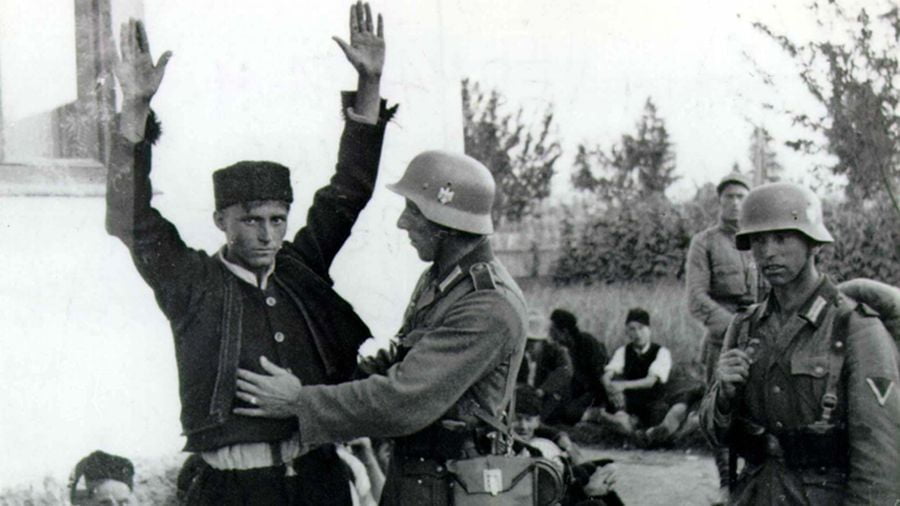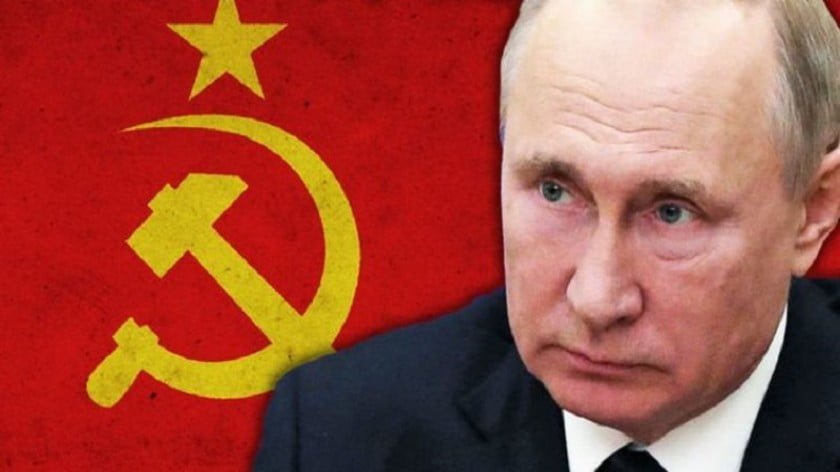History: Nazi Germany’s “Operation Barbarossa” against the Soviet Union, an Overview
The USSR’s hierarchy was caught unprepared, and unnecessarily so, when Nazi Germany invaded their country eight decades ago on 22 June 1941, in a military offensive titled Operation Barbarossa. It was named after King Frederick Barbarossa, a red-bearded Prussian emperor who in the 12th century had waged war against the Slavs.
On the sixth day of the attack, 27 June 1941, German Army Group Center had already reached Minsk, the capital of Soviet Belarus. Amazingly it meant, at this very early stage, that the Germans were closer to Moscow than Berlin: as the crow flies, the Wehrmacht was now 430 miles from the Russian capital as opposed to 590 miles from the German capital.
After a week of fighting, the Soviets had lost around 600,000 troops and thousands of their aircraft had been destroyed, the majority of them on the ground. When on 27 June the Soviet commanders, Georgy Zhukov and Semyon Timoshenko, showed Joseph Stalin on operational maps that the Germans had advanced on Minsk, he was visibly shocked by the magnitude of the disaster. Should Stalin have been so surprised, considering the unprecedented rapidity the year before at which the Germans had blazed through France, Belgium, the Netherlands and Luxembourg?
In the middle of 1941, Stalin had been in charge of the Soviet Union for over a decade whereas, in Germany, Adolf Hitler was in control for little more than 8 years. By the early 1940s, the Wehrmacht was Europe’s most efficient military organization and killing machine. This was in some contrast to the larger Red Army, whose poor display against Finland’s paltry armed forces, from 30 November 1939 to 13 March 1940 (the Winter War), provided stark evidence of the harm imparted on the Soviet military by Stalin’s purges, which had begun in May 1937.
British historian Evan Mawdsley wrote that “the purges certainly played a most important part in what happened on and after 22 June 1941”. Marshal Zhukov, one of the most celebrated commanders in Russian history, was heavily critical of the purges after the war, which will be elaborated upon further here.
It can be mentioned firstly, however, that the extent of the Soviet military purges has tended to be exaggerated and distorted down the years. There were 142,000 Soviet Army commanders and commissars in 1937, just before the purges started. Mawdsley noted, “It is sometimes suggested that half the leadership of the Red Army was wiped out, which was certainly not the case” as “the Red Army commanders and commissars who were shot made up a minority” of the entire Russian military leadership corps.
The damage inflicted on the top ranks was still extensive. Three out of five marshals and 20 Soviet army commanders, along with dozens of corps and divisional commanders among others, were liquidated between 1937 and 1941. The loss of high-level officers inevitably undermined and weakened the Red Army’s command apparatus, and it came at a time when the clouds of war were ominously gathering in Europe.
Marshal Zhukov wrote in his memoirs of “unfounded arrests in the armed forces” which were “in contravention of socialist legality. Prominent military leaders were arrested which, naturally, affected the development of our armed forces and their combat preparedness”.
Altogether, more than 34,000 Soviet officers were dismissed from the military as the purges ran their course, but a third of these (11,500) were eventually reinstated; perhaps most notably Konstantin Rokossovsky, who became one of the most important Soviet commanders of World War II. English author Geoffrey Roberts, writing in his biography of Zhukov, realized that “the vast majority of the armed forces” had “survived the purges”, which is necessary to stress.
Yet in the weeks before and after the German invasion, when the initiative to make crucial and independent decisions was needed, much paralysis reigned in the Soviet high command; which had been disproportionately affected by the purges.
Mawdsley, who specializes in Russian affairs, wrote of the Red Army leaders that were victimized, “These men possessed the fullest professional, educational and operational experience the Red Army had accumulated… Despite professional and personal rivalries among themselves, these leaders had formed a fairly cohesive command structure. The paradox is that this is why Stalin mistrusted them”.
An eminent Soviet diplomat, Andrei Gromyko, who was the USSR’s Foreign Affairs Minister from 1957 to 1985, was first introduced to Stalin in 1939 and saw him many times thereafter. Gromyko became acquainted too with Soviet Army dignitaries like Zhukov. In Gromyko’s book ‘Memories: From Stalin to Gorbachev’, he wrote that Zhukov “spoke bitterly of the enormous damage Stalin had inflicted on the country by his massacre of the top echelons of the army command”.
Gromyko recalled Zhukov saying of the Soviet military men that were purged, “Of course, I regard them as innocent victims. Tukhachevsky was an especially damaging loss for the army and the state”. Marshal Mikhail Tukhachevsky, known overseas as “the Red Napoleon”, was a central figure in the Russian Army’s modernization during the 1920s and 1930s. Zhukov first met Tukhachevsky in 1921 and he later described him as, “A clever, knowledgeable professional, he was splendidly conversant with both tactical and strategic problems… Tukhachevsky was an ace of military thinking, a star of the first magnitude among the great soldiers of the Red Army”.
Zhukov stated that he himself came under suspicion as the purges were unfolding, due to his connections to some of the accused. He vigorously defended his position and avoided censure. Moreover, Zhukov informed Gromyko, “Before the war, the political decision to arm fully was taken very late, and that was the main problem”.
While Zhukov’s criticism on the latter point is also valid, Stalin had engineered a massive increase in the Soviet arms budget from the early 1930s onward, and for this he should be commended. Part of Bolshevik ideology is a belief in the virtue of motorized machines and warfare, without which the Red Army could not have defeated the Wehrmacht and its panzer divisions. Five months before the German attack Stalin told his senior commanders, “the winning side will be the one with the greater number and the more powerful engines”.
Between 1932 and 1937, spending on the Soviet military increased by 340% in overall terms, undoubtedly as a result of Stalin’s direct influence. Through 1937 to 1940 expenditure doubled again on the Soviet defense budget. From 1939, the USSR was constructing over 10,000 warplanes per year, along with almost 3,000 tanks, more than 17,000 artillery pieces and 114,000 machine guns. Payment and conditions for Soviet officers had meanwhile improved greatly, so it was far from being all doom and gloom.
The above figures on Soviet armed capacity were unknown to the Germans; that is, until after they had attacked the USSR, when it soon became obvious the Red Army was much more formidable than Nazi intelligence had estimated. As Mawdsley revealed, German agencies calculated that the Russians had 10,000 tanks in June 1941, whereas in reality they possessed 23,100 tanks. The Germans thought there were 6,000 Soviet aircraft in mid-1941, but in the whole of the USSR there were 20,000 planes, with 9,100 of these positioned near the Nazi-Soviet border.
Under Stalin’s leadership the Russians achieved a remarkable relocation of industry eastwards, in the months following the German assault. This policy was critical to ensuring the Soviet Union could continue producing weaponry en masse, and largely secure from the Nazi onslaught.
Irish professor and geographer John Sweeney wrote, “Over 1,500 industrial enterprises were transplanted, between July and November 1941 alone, to what were considered relatively safe refuges in the interior. The Urals (which received 667 of these enterprises), Kazakhstan and Central Asia (308), West Siberia (244), the Volga Region (226) and East Siberia (78), benefited permanently from this massive injection of industrial investment, and it was in this heartland area that urban growth during the post-war recovery period was concentrated”.
Relating to manpower, the Red Army was likewise significantly bigger than Hitler and his generals believed. In June 1941 Soviet forces consisted of more than 300 divisions, amounting to 5.5 million personnel, 2.7 million of which were stationed in the western USSR. The Germans thought there were only 200 Russian divisions in existence, despite the fact the Soviet population was appreciably greater than Germany and Nazi-occupied Europe combined. In comparison the German invasion force comprised of 3 million men, supported by less than a million troops from its Axis allies such as Romania and Finland, led by the anti-Bolshevik military leaders Ion Antonescu and Gustaf Mannerheim respectively.
Seven weeks into the German invasion, General Franz Halder acknowledged in his diary, “The whole situation makes it increasingly plain that we have underestimated the Russian colossus”. Not long after, even Hitler admitted in a speech in central Berlin, “We had no idea how gigantic the preparations of this enemy were”.
Zhukov and Timoshenko were acutely aware of the massing of German, Finnish and Romanian divisions adjacent to the USSR’s boundaries. The Soviet Army’s foreign intelligence agency (the GRU) confirmed on 15 June 1941, just a week before Operation Barbarossa commenced, that a huge transfer had taken place of German forces to the Nazi-Soviet frontier; with 120 to 122 Wehrmacht divisions reportedly deployed there.
Zhukov told Stalin repeatedly, and as late as mid-June 1941, to be prepared in the case of a German attack. Stalin in turn insisted a few days before Wehrmacht-led armies invaded, “Germany has a Treaty of Non-Aggression with us. Germany is involved up to its ears in the war in the West, and I believe that Hitler will not risk creating a second front for himself by attacking the Soviet Union”.
From November 1940 to June 1941, Stalin personally received a total of 80 intelligence reports warning about a German invasion, according to English historian Andrew Roberts. In mitigation to Stalin, a fair proportion of the intelligence accounts proved inaccurate regarding the invasion start date; others constituted misinformation planted by the Germans; but most reports were genuine and some uncannily close to the mark, like the material sent to the Kremlin by Richard Sorge, a now famous Soviet spy then operating in the German embassy in Tokyo.
Stalin was further warned about Nazi intentions by Soviet agents like the courageous Leopold Trepper in Paris, and also Victor Sukolov in Belgium. The most plausible and detailed reports of all indeed came from Soviet sources, and they peaked in intensity during the first three weeks of June 1941 – along with alarming information forthcoming that Hitler’s allies Finland and Romania were mobilizing for war against Russia. This could not be ignored.
Robert Service, in his lengthy book on Stalin, wrote that, “For weeks the Wehrmacht had been massing on the western banks of the River Bug, as dozens of divisions were transferred from elsewhere in Europe. The Luftwaffe had sent squadrons of reconnaissance aircraft over Soviet cities. All this had been reported to Stalin by his military intelligence agency. In May and June [1941], he had been continually pressed by Timoshenko and Zhukov to sanction the dispositions for an outbreak of fighting. Richard Sorge, the Soviet agent in the German embassy in Tokyo, had raised the alarm. Winston Churchill had sent telegrams warning Stalin. The USSR’s spies in Germany had mentioned the preparations being made. Even the Chinese Communist Party alerted Moscow about German intentions”.
By the second half of June 1941, Stalin was counting on it being too late in the year for the Germans to attack. Regardless, the French commander Napoleon, generations before fast-moving motorized vehicles emerged, had launched his invasion of Russia on 24 June 1812, two days later in June than the Germans.
In addition the spring rains arrived late in the western USSR in 1941, and they were much heavier than normal. Many of the river valleys, including the strategically important River Bug in eastern Poland, were still flooded at the late date of 1 June 1941. This meant that an attack on the Soviet Union could not have proceeded until after then.







